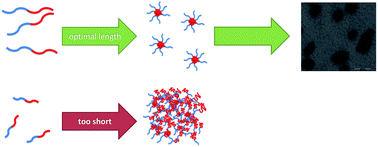A quantitative recipe for engineering protein polymer nanoparticles†
Abstract
Protein polymers can assemble switchable nanostructures with emerging applications as biomaterials and nanomedicines. For example, above a critical micelle temperature (CMT) some elastin-like polypeptide (ELP) diblock copolymers assemble spherical nanoparticles, which may modulate cellular internalization and in vivo biodistribution. To achieve engineering-level control over their properties, this report explores a comprehensive library of ELP monoblock and diblock polymers. For the first time, we report that a surprisingly high core molecular weight is required for stable nanoparticle formation; furthermore, nanoparticle size depends on polymer molecular weight. A mathematical model was developed to characterize four ELP monoblock libraries and to predict the phase behavior of corresponding diblock copolymers. The CMT was almost entirely dependent on the hydrophobic core ELP, while the bulk phase transition temperature (Tt,bulk) depends predominantly on the hydrophilic block. Nanoparticle assembly was accompanied by a conversion in secondary structure of the hydrophobic block from random coil and β-sheets to type-2 β-turns. For the first time, this report enables the rational design of ELP protein polymer nanoparticles with physico–chemico properties that will be suitable for biological applications.


 Please wait while we load your content...
Please wait while we load your content...